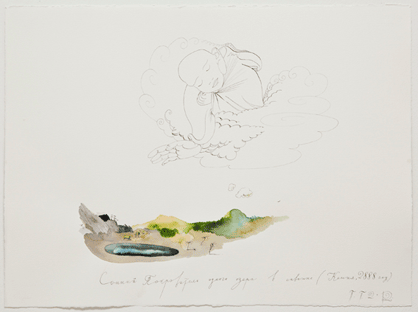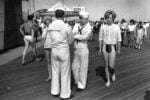Marco Basta / Pavel Pepperstein

Mostra personale di Pavel Pepperstein nella main room e mostra personale di Marco Basta nella project room.
Comunicato stampa
We are pleased to announce an exhibition of new works by Russian artist Pavel Pepperstein.
Pavel Pepperstein is one of the most influential artists of Russias new generation. In 1987 he co-founded the experimental group of artists Inspection Medical Hermeneutics, which, after the dissolution of the Soviet Union, developed a critical approach towards the influence of Western culture on Russia. Pepperstein works in may different media. Installations, wall paintings, videos, subtle water colors and graphic works area all aspects of his work; besides that he is also a writer, well known in Russia for his vast fantasy epic The Mythogenic Love of Castes (with S. Anufriev) and his detective novel The Swastika and the Pentagon.
But for Pepperstein both fine art and literature are only instruments of investigative activity writes Irina Kulik in the catalogue of the Russian Pavillion at the Venice Biennale of 2009, ...He examin-es contemporary art, mass culture and philosophy to discover the sources of this 'mythogeny'. The artistic strategy of Pepperstein and Medical Hermeneutics basically consists of artificially creating a self~contained subculture. Its curious vocabulary of terms, references, and designations, whose meaning is often known only to initiates, is interestingly enough, especially convincing and effective to outsiders.
Pepperstein's drawings and watercolors generate an astonishingly compact and mystically charged atmosphere. He denies the apparent virtuosity of his technique by a mirror effect creating a complex game between the figures made with his right hand, and the ones created with his unskilled left hand. At the Russian Pavillion of the Venice Biennale in 2009 he showed the suite of watercolors Victory over the Future in which he imagined the world in the styles of different artistic movements, political ideologies and utopias. In the suite of new water colors from 2012 that we will present in Milano, he has imagined different gods watching over different parts and aspects of the world.
Pavel Pepperstein was born in 1966 in Moscow as son of artist Viktor Pivovarov and author Irina Pivovarova. He studied at the Academy of Fine Arts in Prague and has exhibited his work in numerous venues, among them at the Venice Biennale in 1993 and in 2009, Berlin-Moscow at the Gropius Bau in Berlin 2003, the San Paolo Biennale in 2004, the 1st (2005) and the 3rd Moscow Biennale in 2009. He has had solo shows at Akademie Schloss Solitude, Stuttgart in 1999, at Kunsthaus Zug in 1999 and 2002, at Neuer Aachener Kunstverein in 2002, Kunsthalle Düsseldorf in 2003, Museum für Gegenwartskunst Basel in 2006 and the Contemporary Art Gallery, Vancouver in 2007.
Project Room: Marco Basta Rainy Days
In the Project Room we present the young Italian artist Marco Basta, born in Milan in 1985.
His work inhabits the creek between the attempt to enclose and listen to inner, intimate space, and the need to create a gaze that can decipher and measure that chaotic external space that is reality. It is the attempt to capture something that constantly eludes us, whose meaning always lies elsewhere and can thus be established through memory, and therefore possibly through the image. The works address this everyday cognitive path, this time of waiting, this difficulty.
The idea of Rainy Days arises through striving to record and to give form to the random quality of an atmospheric phenomenon that in itself cannot be captured if not with the gaze. The drops of rain are captured by means of a scanner on which the artist breathes to create vapors and movements. The resulting image is then shifted towards different chromatic tones and then printed on different types of paper from Japan, Bhutan, Africa and Germany. The paper is prepared with a mother-of-pearl pigment on which the ink from the printer is applied. The results are translucent sheets that range from light to dark shades, similar to tones of water or the sky during a rainstorm. They could also be simply backgrounds, or landscapes. Apart from the drop of water, which remains the sole instance of representable form, the rest is simply color, sensations of a watery quality, vapors, the fluctuating movement of drops. Every sequence tries to approximate the chromatic idea of the season in which the rain was captured, using the colors that appear in that particular time. Almost a catalogue of emotions, details, fragments, hints of the personal recollection of a season.
The show will also include two ear-shaped vases, to facilitate listening to their inside, hearing of their invisible content. In the folk tradition seashells are often associated with the sound of the sea or the wind; they are thus seen as objects that convey the sound of their own origins, associated with memory. Also in the folk tradition, another marine creature with similar characteristics (as a shelter, for example), the oyster, when found in a fossilized state was associated with the idea of an ear of a non-human being. Thus it always leads back, in a way, to sound, and to an almost fable - like, mythical memory. Marco Basta has made these vases by attempting to approach some of the characteristics of the Japanese pottery known as Mino. The surprising aspect of this pottery is that it manages to achieve incredible beauty through imperfection, deformity, asymmetry and chance. Finding a bees wing is a rare event. The most instinctive gesture is to hold it in ones fingers and to observe it from all angles. It is almost nothing, a thing that is practically invisible and exists only in reflections. Such an insignificant event can create a precious, intimate moment. In the imagery of painting the hand has always been a vehicle of otherness, since the offering or holding in the fingers seems almost to indicate something that is there, yet exists elsewhere.
Marco Basta has shown work in the exhibition Vedere un oggetto, vedere la luce at Palazzo Re Rebaudengo at Guarene dAlba in 2011 and at Gasconade in Milan in 2012. His work can presently be seen at the Galleria dArte Moderna in Milan, in the group show Fuoriclasse curated by Luca Cerizza.



